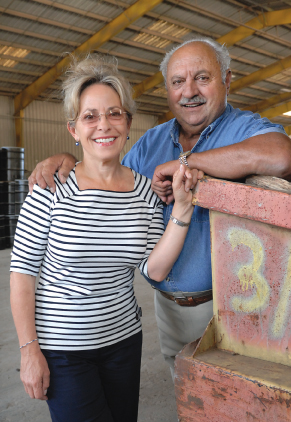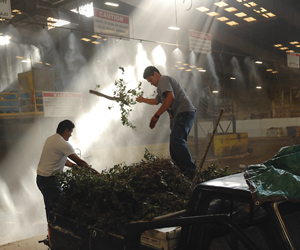A dizzying array of garbage circles around on various conveyor belts as magnets yank out metal and aluminum, bottles plunge below to bins and blowers separate out paper.
The whirling machinery at the Marin Recycling Center is reminiscent of Charlie Chaplin’s movie Modern Times, but the hum from this San Rafael facility is the sound of conservation, not consumption. It is a very real counterpoint to the dehumanizing influence of industry so poignantly skewered in Chaplin’s film. And the racket is music to the ears of Joseph Garbarino, who has made a career out of turning trash into treasure.
“It’s a great system to watch,” says Garbarino, chairman of Marin Sanitary Service, as he watches workers operating the machinery at the enormous Resource Recovery Center. “I remember when we used to do all this by hand at one fifth the speed.”
Things have changed since the days when Garbarino had to pick through truckloads of trash for recyclables. His family business, which started out in Marin in 1956 with eight men and eight garbage trucks, now employs 240 people and operates what many believe is the most sophisticated recycling plant in the country.
Marin Sanitary began the first curbside recycling program in the country 28 years ago and is now number one in the state in pounds recycled per person per day, according to the California Solid Waste Management Board. While many waste management companies struggle to recycle even half of what they collect, Garbarino’s facility recycles 77.6 percent of the 250 tons of residential trash it takes in daily in Marin.
 “The collaborative manner in which we approach management of solid waste is what has allowed us to be so successful,” says Patricia Garbarino, president of her
“The collaborative manner in which we approach management of solid waste is what has allowed us to be so successful,” says Patricia Garbarino, president of her
father’s company.
Marin Sanitary has worked with environmentalists, politicians, merchants and contractors for more than three decades. It has agreements with a variety of companies, including many overseas, allowing them to reuse the recycled material produced in the Marin plant.
“Americans make up 5 percent of the world’s population and we produce 30 percent of its trash,” says Patty Garbarino, who regularly speaks at high schools and civic and trade association meetings on the economics of recycling. “We’re going to drown the next generation in our trash and use up our natural resources if we don’t do something. Our recycling effort is hopefully keeping people from using stuff taken from the ground by reusing what’s already on top of the ground.”
Statewide, that effort is now considered a model for other recycling efforts. Many provisions in the 1989 state law called the Integrated Waste Management Act were patterned after the program Marin Recycling was already running in San Rafael. Last year, the company was honored for pioneering what became a successful campaign to halve the amount of trash dumped in California’s landfills. In 1990, California recycled just 10 percent of its waste; it now diverts 52 percent of the 76 million tons of solid municipal waste generated per year.
How it began
It all started in 1948 when Joe Garbarino was 15 and working for his father, Gianni. In the 1920s, Joe’s father and uncle formed San Francisco’s first Scavenger’s Protective Association (which later became Golden Gate Disposal & Recycling Company). They hauled giant burlap sacks full of garbage and sifted through them for empty wine bottles to sell back to Napa wineries. Joe Garbarino picked out shoes to be resoled and salvaged zippers, buttons and rags for use on ships and in factories. The company had a rag- and bottle-washing plant.
When it was time to pursue his own vocation, Joe studied to be a pharmacist at City College of San Francisco, where he was student body president. He was about to start further studies at UCSF in 1955 when the opportunity to run a scavenger service like his father’s opened up in Marin. He couldn’t pass it up.
In 1979 — well before the public or government had even considered the idea — Garbarino, working with conservationists Gloria Duncan and Ted Wellman, launched the nation’s first countywide curbside recycling program. As Garbarino expanded his business, he combined garbage collection with recycling procedures and acquired ever more sophisticated sorting machines. In 2003, the Marin Recycling Center established the first collection yard in California for the detritus from trees with Sudden Oak Death.
Residents, contractors, tree services and garbage companies now dump wood, yard waste, dirt, rock, concrete, demolition debris, and refrigerators and other appliances at the company’s Resource Recovery Center, an indoor dump in San Rafael the size of three football fields. The pile includes trees that are later chopped up for firewood or ground up to make topsoil or fuel for power plants. “We’ll get all that wood out,” says Garbarino, gesturing toward a big pile of construction debris and other rubbish. “We operate the grinder at night to save power. You got oak, you got pine, you got eucalyptus. You grind it up and mix it with dirt and you’ve got a fantastic product.”
Freon is removed from refrigerators and given to companies to reuse. Metal pieces, including entire automobiles, are crushed into cubes or cut into bundles to be shipped overseas, melted and reused. Asphalt, brick and concrete are ground up for use as aggregate in road base or for landscaping.
“We’re reusing the same material over and over by grinding it,” Garbarino says. “All of it goes overseas to China, Vietnam, Korea and other Asian countries,” where it is used to make consumer products, a lot of which are then sold in the United States.
 Outside and across the road from the dump, Garbarino points out a wildly vibrating machine with a bowl on top, into which dirt and debris are being shoveled via a caterpillar. The machine, powered by a large piston, spews out topsoil on one side and gravel on the other. “I lease this land to American Soil Products,” he says. “People dump their debris and then go across the street to pick up gravel and other products. The consumers may very well be buying a product made out of the same stuff they dumped the week before.”
Outside and across the road from the dump, Garbarino points out a wildly vibrating machine with a bowl on top, into which dirt and debris are being shoveled via a caterpillar. The machine, powered by a large piston, spews out topsoil on one side and gravel on the other. “I lease this land to American Soil Products,” he says. “People dump their debris and then go across the street to pick up gravel and other products. The consumers may very well be buying a product made out of the same stuff they dumped the week before.”
Even the unused wet concrete from cement mixers goes to good use. “See all these walls?” Garbarino points out the towering barrier surrounding the giant complex. “They are made out of leftover concrete.”
Loaves of stale bread, outdated milk and other discarded foods are fed to Garbarino’s pen of pigs, incorporated into the recycling program in 1985. The food becomes fertilizer by way of the pigs’ natural digestion. The paper, cans and plastic that people put in their blue curbside recycling bins go to the recycling center in a building near the indoor dump.
There, tin and aluminum cans are pulled off a conveyor belt by an ingenious system of magnets. Bottles are dropped down below into bins. Blowers, conveyors and workers then sort the newspaper and other paper products from the plastic.
The aluminum is sold for 90 cents a pound, cardboard fetches seven cents a pound and newsprint goes for about five cents a pound. Garbarino can get 20 cents a pound for plastic bottles made of resin types 1 and 2, but plastic bags, bottle caps, TV dinner trays, plant pots, VCR cassettes and compact discs for the most part are not recyclable.
“Look at this.” He stops in front of a huge pit filled with organic waste and large quantities of plastic being loaded into trucks to be taken to the landfill. “Almost all plastic. It will be there for 1,000 years. It’s horrible.”
In another effort to cut the environmental impact from plastics, Marin Sanitary is involved in the campaign to ban plastic bags in Bay Area supermarkets and stores. “The main problem is that plastic blows out of garbage cans and gets into streams and the ocean,” Patty Garbarino says. She’s also leading an effort to convince people to stop using plastic water bottles: “There is a gyre of plastic in the ocean that is the size of Texas. The plastic breaks down into tiny particles that fish and other animals eat because it looks like food. It’s a killer.”
The ultimate goal is to save trees, precious metals, water, energy and landfill space. “People didn’t even know what we were doing when I got started,” Joe Garbarino notes. “Now it is becoming quite clear that the whole world should be doing what we are doing in San Rafael.”
Image 2: Founder Joe Garbarino wit his daughter, Patricia, who is now president of her father’s company.
Image 3: Workers sort through yard waste in an indoor dump the size of three football fields.


